What is audio compression, limiting, leveling and normalization? Learn how make your sound clear and professional!
Ever recorded an audio part, like a guitar recording, a vocal track or a voice over for a podcast or YouTube video? Well it may have happened to you, as to most of us, that the volume varied a bit too much throughout the recording. There were parts that were too low, perhaps someone was too far away from the microphone, the guitar guy swayed a bit during some part or the people in the studio were in different distances from the mic. Then someone raised their voice or slammed on the keys or the strings a bit too much making that part very strong. Basically, the lowest volume level is way too low to meet the highest volume with a nice finish. This is the essence of what we in the audio industry call dynamic range. The dynamic range of volume.
Dynamic range of an audio recording is just that, how dynamic, or big, the differences are from the lowest volume level to the highest. And now we want to minimize that range to suit our production, be it a podcast or a musical masterpiece. There are a couple of ways to accomplish this, but the most common is to use audio compression. An audio compressor is the tool of the trade.
Compressors vs. Limiters
There are many forms of compressors. Some stop the sound very gently as the sound level reaches too high values, some stop it faster and harder. Most compressors can do both. The ones that stop it very fast and harshly (instantly) are called limiters. These are just different types of compressors that are usually used for drums, on mix buses or on outputs of complete projects or songs. This is to stop the sound peaks from reaching too high values which would otherwise result in digital clipping. Limiting is heavily used in mixing and mastering, as it can help raise volumes of entire productions. Through the use of compressors and limiters we can make our song sound as things do on the radio, or just sound more steadier and even. There is always a trade off, using compressors and limiters, as they tend to squash the life out of a natural sound very easily. We must therefore use them in moderation and with the appropriate settings for the sound in question.







